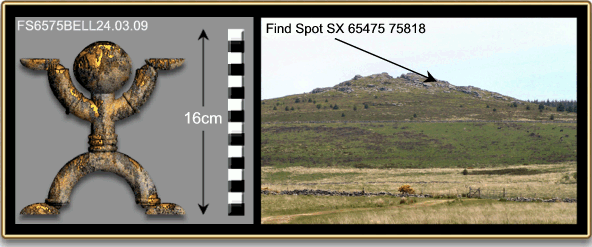
Before we get to the astounding news that has just been announced to the world of archaeology let me put a quote past you in order to get some sort of context of what can only be described as a startling discovery at Bellever Tor:
‘This tor (Bellever), owing to the absence of others in the immediate vicinity – for Laugh Tor is of little account – rises boldly above the newtakes, and is more shapely than many lately encountered. Its name, in common with the tors of Bel and Belstone, has been derived from Baal, or Belus, the sun god whose worship it is said, was introduced into Britain either by the Phœnicians, or, say those who are of the opinion that the whole religion of the early inhabitants of our islands had Eastern origin, at a still earlier date.’, (Page, 1895, pp.165 – 166).
For centuries there has been a tradition on Dartmoor that the ancient tribes that lived around Bellever belonged to a cult which worshipped the sun and the god Belus in particular as demonstrated by Page’s remarks. In recent times, due to a greater understanding of prehistoric features, this idea has always been ridiculed and dismissed out of hand. Granted there are numerous Bronze Age settlements and ritual monuments scattered all around Bellever Tor and nearby Laughter Tor and that it must have been regarded as a sacred landscape of some sort. It has also been demonstrated that the actual name of the tor – Bellever has derived from its earliest document name of 1355 – Welford, a compound of the words wielle and ford, (Gover et al. 1992, p.162). If correct, this clearly is nothing to with the name of Ball or Belus or so until recently one may be forgiven for thinking so?
On March the 8th 2009 a family from Tewkesbury (who wish to remain anonymous) were out on a letterboxing excursion on and around Bellever and whilst hunting among the many rocks and crevices on the eastern side of the tor came across a strange object poking out of the peat. Having heard all the horrific stories of unexploded ordnance which scatters the moor they quite sensible were very cautious about their discovery. However, curiosity finally overcome them and the small object was carefully lifted from the soil and the peat cleaned off with a handkerchief thus revealing what appeared to be a small, metal statue. As more and more of the dirt was removed the artefact began to show signs of a rich golden colour, it was at this point that the father realised that they possibly may have found a very important find.

The Bellever Idol and its find spot
Having returned home the man, for some strange reason, sent me a photograph of the object and asked if I had any idea what it was. Sadly the photo was taken on the family’s return to their home and not in-situ which would have been a great help. Clearly I am no expert in ancient idols but it was obvious from the picture that the object was of some considerable antiquity, possibly made of gold and one that should be reported to the Portable Antiquities Scheme immediately. On Monday the 8th of March the artefact was reported to the PAS office at the Exeter museum and on Tuesday the 10th of march the find was collected and taken back to Exeter for examination. On examination it was decided to send the Bellever Idol on to the British Museum in London for further investigation and conservation. Once the conservator had cleaned the object it was confirmed that indeed it was made of gold, measured 14.9cm tall and spanned 10.2cm and weighed 43.2gms.

A conservator at work on the idol
Fortunately Professor Mark Beale was visiting Exeter University in order to give a lecture on ‘Prehistoric Icons and Religious Symbols’ and when contacted he agreed to examine the statue prior to it being sent to the British Museum. It seems that in his expert opinion the artefact is associated with the Celtic god Belenus who was known as the ‘Shining One’ or ‘Bright One’. Belenus was said to have been the overseer of cattle and sheep and it was to him that the Beltane Fires were lit on May Day. There can be no doubt that the early settlers who lived around Bellever Tor kept cattle and sheep which to them would have been valuable assets in need of divine protection. In Joe King’s opinion this is one of the most important finds for at least 100 years and is only the second ever representation of a prehistoric god to be found in Devon, he also estimated that by design the artefact must be at least 3,000 years old. The gold content alone makes the discovery unique as there is very little naturally occurring gold to be found on Dartmoor which means the object had been imported to the region
Luckily the letterboxer who found the statue took a grid reference of the find spot with his GPS and so having this information an investigation team will be visiting the site to ascertain of there are any further finds awaiting discovery. In the mean time the golden statue remains at the British Museum for further investigation, it is hoped that metallurgical tests could reveal the geological source of the gold which in turn may give some indication of the country of origin. In Mark Beale’s opinion this is one of the most important finds for at least 100 years and is only the second ever representation of a prehistoric god to be found in Devon, he also estimated that by design the artefact must be at least 3,000 years old. The gold content alone makes the discovery unique as there is very little naturally occurring gold to be found on Dartmoor which means the object had been imported to the region
Here is an excellent example of how a small grain of truth has lodged itself in Dartmoor legend and has travelled down through the millennia to once again become a fact in modern times.
Reference.
Gover, J.E.B., Mawer, A. & Stenton, 1992. The Place-Names of Devon, Nottingham: The English Place Name Society.
Page, J. Ll. W. 1895. An exploration of Dartmoor, London: Seeley & Co. Ltd.
 Legendary Dartmoor The many aspects past and present of Dartmoor
Legendary Dartmoor The many aspects past and present of Dartmoor

Where is the reference for this item? I’m trying to find out more about it, to see if there’s a reference anywhere or an article – i’m using it in an essay!
Hope that you can find it soon – my essay is due Monday :O
Many thanks,
Jowan
Sorry to burst your bubble but it was posted on April the 1st for an April Fools wind-up.
So this article is all false? The post date says March 25th. I was sad to see your comment at the end after reading the article.